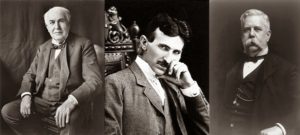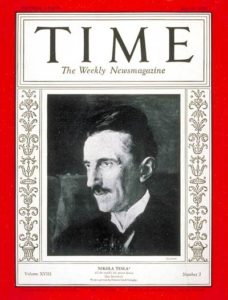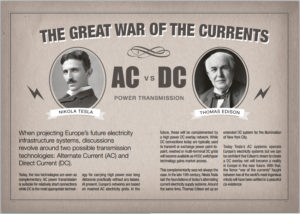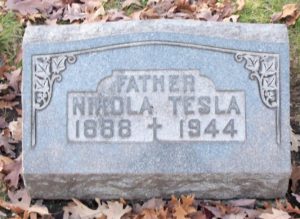He’s been dubbed the “patron saint of geeks” and has had electric cars, rock bands, a unit of measurement, a minor planet and a lunar crater named after him. Yet visionary scientist Nikola Tesla is still relatively unknown, eclipsed by contemporaries such as Edison and Marconi. And he died impoverished and largely forgotten.
During his lifetime, he gained international fame for his invention of a system of alternating current that made possible the distribution of electricity over vast distances and is the basis for the electrical grid that powers 21st century life. But the visionary Tesla imagined much more—robots, radio, radar, remote control, the wireless transmission of messages and pictures, and harnessing the wind and sun to provide free energy to all.
A showman, he dazzled his scientific peers who flocked to see him demonstrate his inventions and send thousands of volts of electricity pulsing through his body. His fertile but undisciplined imagination was the source of his genius but also his downfall, as the image of Tesla as a “mad scientist” came to overshadow his reputation as a brilliant innovator. But it is his exhilarating sense of the future that has inspired renewed interest in the man, as his once scoffed-at vision of a world connected by wireless technology has become a reality.
PBS introduces him to audiences in the DVD American Experience: Tesla. The program is also available for digital download.
Born in 1856 to a Serbian family in Croatia, the tall, gangly, 28-year-old inventor arrived in New York in 1884, almost penniless but with a letter of introduction to his hero, Thomas Edison. Tesla was convinced that he had solved the problem that had plagued Edison’s plans to electrify the world, not just the tip of lower Manhattan. Edison relied on direct current (DC) to transmit electricity, which was severely limiting. Tesla had found a way to do what had so far stumped everyone: invent a motor that could run on alternating current (AC), making the distribution of electricity across long distances possible.
“Before Tesla, you would have to have thousands of little power plants at every mile,” explains biographer Marc Seifer. “After Tesla, from one power source—Niagara Falls—you could light up and power the entire northeast.”
Edison immediately hired Tesla, who abruptly quit just six months later, frustrated by Edison’s refusal to adopt his idea. After a grim winter of digging ditches, his luck turned. The wealthy inventor and entrepreneur George Westinghouse knew that the future—and immense profits—would be found in electricity and he quickly bought the young inventor’s patents, making Tesla a rich man. But when Westinghouse became overextended, he revised Tesla’s deal, stripping him of a royalty that would have made him one of the wealthiest men in the world. Nevertheless, Westinghouse’s gamble on Tesla’s ideas paid off; the company beat Edison for the contracts to wire the Columbian Exposition in Chicago and to harness Niagara Falls to generate AC current, ending once and for all Edison’s hopes for his now antiquated DC technology.

Tesla was now a celebrity, the new Edison. He moved into the luxurious Astor House, dined at Delmonico’s, and became a friend to the rich and famous, including Mark Twain, John Jacob Astor and J.P. Morgan. But he was plagued with a plethora of odd phobias that had followed him since childhood, when he often suffered from inexplicable visions and a difficulty in separating reality from his imagination. Everything he did had to be divisible by three, he had a manic fear of germs, and couldn’t bear the sight of earrings or the touch of human hair.
In 1899, Tesla headed west to Colorado Springs where he set up a laboratory and began to build massive coils that produced a million volts of electricity; he soon announced that he could transmit electricity over vast distances by sending currents though the earth. But he never produced the evidence and his credibility slipped, tarnished even further by his claims that he had received signals from Mars. His imagination, so critical to his inventive powers, began to betray him.
Returning to New York, Tesla managed to convince Morgan to invest in his next idea, the transmission of wireless messages, although Tesla dreamed of transmitting electric power without wires as well. With Morgan’s money, Tesla bought 200 acres on Long Island’s North Shore and began building a transmission tower. But an Italian electrical engineer, Guglielmo Marconi, doomed his dream by sending the first wireless transmission across the Atlantic in 1901—based on Tesla’s patents. The invention of wireless telegraphy—radio—would win Marconi a Nobel Prize and send Tesla into a downward spiral.
By 1916, he had relinquished the Long Island mortgage to the Waldorf Astoria Hotel, where he had lived on credit for almost 20 years. He would spend the rest of his life imagining new inventions and searching for investors while his ideas became increasingly bizarre and fantastical, more science fiction than science. His mind drifting, his money gone, he died alone in 1943 in the New Yorker Hotel. Six months later, the U.S. Supreme Court ruled that the patents to Marconi’s wireless device belonged to Tesla, and that he, not Marconi, had launched the wireless world with the invention of radio.
